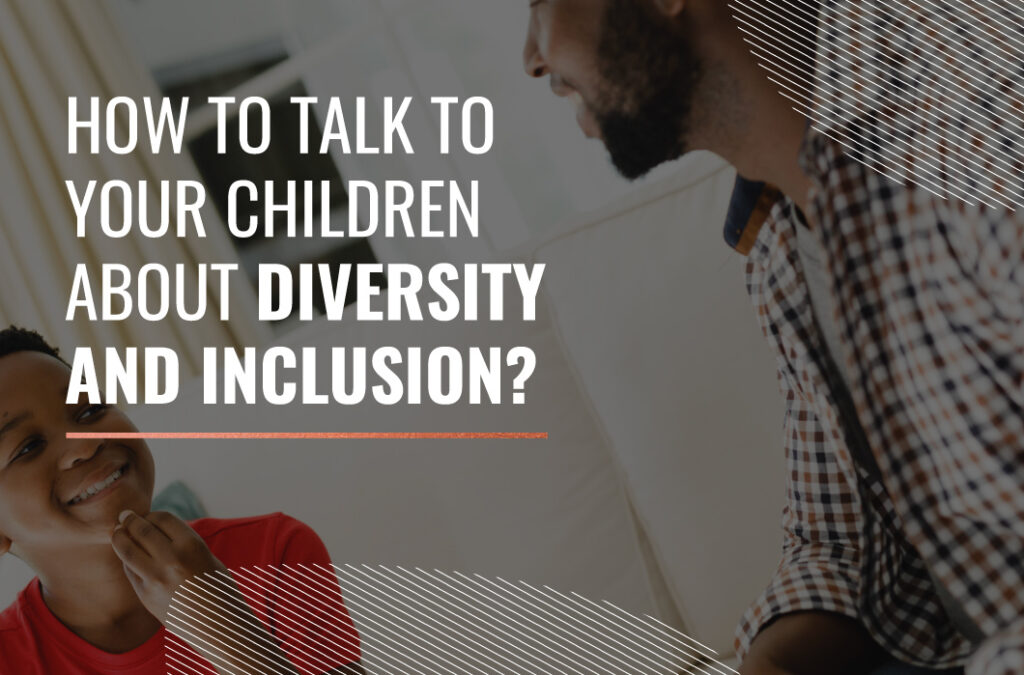I stumbled upon intriguing data from Instant Offices, revealing a significant 122% increase in interest in diversity and inclusion since 2010. Even more astonishing, searches for ‘diversity and inclusion for kids’ surged by 200% in 2020 alone. This emphasizes the growing importance of these concepts.
This underscores their significance for parents and children. Teaching inclusive prepares kids for a future where fairness is valued. They must grasp the importance of embracing diversity in their careers and communities as our values evolve with the changing world. Hence, discussing the right age and using resources like books and movies is vital. I’m here to help you navigate this journey.

Here are some questions people ask most often:
How can parents initiate age-appropriate conversations about diversity and inclusion with their children?
As a parent or caregiver, it’s crucial to shape your children’s understanding of diversity and inclusion. Engage in conversations that celebrate differences and teach empathy. Use relatable stories and simple language, and encourage open dialogue. Include resources like books and movies that promote diversity. Highlight the values of empathy and respect, emphasizing how unique backgrounds enrich our society. Address challenges patiently, fostering an environment where open conversations are encouraged.
Engage in conversations that celebrate differences and teach empathy. Use relatable stories and simple language, and encourage open dialogue.
What are some effective ways to explain complex concepts like discrimination and privilege to young children in a way they can understand?
Navigating the terrain of explaining complex concepts like discrimination and priviledge to young children is a delicate task. It requires creativity and sensitivity to make these intricate ideas accessible to their developing minds. Try to…
- Explaining complex ideas like discrimination and privilege to young children with creativity and sensitivity. Make these concepts understandable by using relatable situations and age-appropriate language. For discrimination, use examples of the times when a child felt excluded. For privilege, compare it to having advantages, like reaching high shelves.
- Visual aids, like simple drawings, help make these ideas clear. Show how discrimination affects people and how privilege can affect opportunities. Encourage empathy by asking how children would feel in similar situations.
- Stories are powerful tools. Use children’s books to discuss these topics and explore characters’ experiences together. By using relatable examples, visuals, empathy, and stories, parents can help children understand discrimination and privilege. This sets the stage for children to be aware of these issues and treat others fairly.
When is the right time to start discussing diversity and inclusion with kids?
Understanding when to discuss diversity and inclusion with children is a thoughtful process that evolves with their age.
- Conversations can begin quite early, as children are naturally curious. A good starting point is to incorporate diverse perspectives into everyday activities, creating an open and inclusive atmosphere. When children are young, the focus can be on teaching them to value differences. This can involve reading books with diverse characters and participating in cultural events to help them understand that our world is made up of many unique cultures.
- As they reach ages 5 to 7, you can delve deeper into discussions about kindness and respect for everyone, regardless of their differences. This is a suitable time to introduce the concept of discrimination, explaining what it means and why it’s hurtful. Keep the explanations simple and emphasize the idea of fairness.
- In the pre-teen and teenage years, conversations can become more complex. You can introduce the concept of privilege, where some individuals have advantages due to their background, and discuss the historical and societal factors contributing to these differences. Encourage critical thinking and reflection during these discussions.
Throughout all stages, it’s essential to keep the conversation evolving. Adapt your approach to their age and understanding, and encourage them to ask questions and share their thoughts. This way, they can explore these topics deeply and develop their own perspectives.

What are some practical tips for maintaining an open and ongoing dialogue about diversity and inclusion within the family?
Keeping an ongoing dialogue about diversity and inclusion in the family needs commitment and a nurturing environment. Here are practical tips to make these conversations meaningful:
- Lead by Example: Show respect and inclusivity in your actions.
- Safe Spaces: Create comfort for questions and thoughts.
- Regular Talks: Set aside time for family discussions, like meals or weekly meetings.
- Real-Life Examples: Use news or personal stories for chats on fairness and understanding.
- Active Listening: Let kids talk fully before responding.
- Critical Thinking: Encourage different perspectives and ask questions.
- Celebrate Diversity: Embrace different cultures and traditions.
- Address Challenges: Tackle discomfort openly and constructively.
- Keep Learning: It’s okay not to have all answers; learn together.
By following these tips, your family can have ongoing conversations about diversity and inclusion, fostering understanding and empathy in everyday life.
Are there recommended resources such as books, movies, or games that can help reinforce the understanding of diversity and inclusion for children?
Of course! There are a plethora of recommended resources like books, movies, and games, that can effectively reinforce children’s understanding of diversity and inclusion while making the learning process enjoyable and engaging:
Books:
- “The Colors of Us” by Karen Katz: This picture book celebrates the diversity of skin tones through a young girl’s exploration of her multicultural neighborhood.
- “All Are Welcome” by Alexandra Penfold: A heartwarming story that promotes inclusivity, showing children from various backgrounds coming together in a school setting.
- “The Family Book” by Todd Parr: Through simple and vibrant illustrations, this book celebrates all types of families, reinforcing the idea that differences are to be embraced.
Movies:
- “Zootopia”: This animated film explores themes of prejudice and stereotypes in a fun and relatable way, as a bunny cop and a cynical con artist fox team up to solve a mystery.
- “Coco”: Centered around the Mexican holiday Dia de los Muertos, this movie teaches about family, tradition, and celebrating the lives of loved ones.
- “Hidden Figures”: Based on a true story, this movie showcases the achievements of three African American women mathematicians at NASA, promoting the importance of inclusivity in history.
Games:
- “Heads Up!”: This charades-style game encourages players to guess words or phrases related to diversity, culture, and identity, sparking conversations in a lighthearted way.
- “Sesame Street: Ready for School!”: Interactive games within this app teach early learners about diverse cultures and promote inclusive values.
- “Global Kids”: An online platform offering educational games that teach children about different countries, traditions, and lifestyles around the world.

What are some potential challenges parents might face when discussing diversity with children, and how can these challenges be overcome?
Discussing diversity with children can present challenges, but parents can navigate them effectively. Simplify complex concepts, use age-appropriate language, and encourage questions to help kids understand. Address tough conversations gently, focusing on empathy rather than fear. Create an open space to address resistance and clarify misunderstandings.
Counteract societal influences by discussing stereotypes and promoting critical thinking. Tailor discussions to each age group, and be culturally sensitive by learning alongside your child. Address emotional overwhelms with support and validation, and explain privilege using examples. It’s okay not to have all the answers; research together. For parents from different backgrounds, use resources and involve your child in learning. By embracing these strategies, parents can foster a supportive environment for discussions on diversity, turning challenges into opportunities for growth and learning.
Tailor discussions to each age group, and be culturally sensitive by learning alongside your child.
Nurturing inclusion and diversity with kids
Talking to your kids about diversity and inclusion is like giving them a map for life. It’s not just about being fair and kind; it’s about helping them succeed in a world that likes when people are different. So, start early, keep it simple, and talk openly. You’re not just teaching them; you’re helping them be part of a world that values everyone. It might be tricky at times, but with patience and understanding, you’re guiding your kids toward a world where being different is a good thing.
Remember, start early, keep it simple, and let the conversation evolve as they grow. The journey may have its challenges, but with patience and understanding, you’re guiding your children towards a world where diversity is not just acknowledged but celebrated.

Author: Anel Martínez (Sexual Coach at MYHIXEL)
Sexologist specializing in sex therapy and sex education, mental health and human behavior.
Do you have any questions about our online consultation service? Contact us through our WhatsApp Business +34 643 84 91 23






